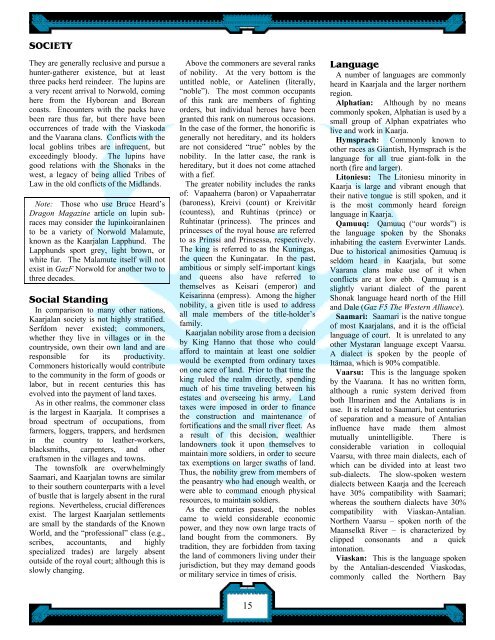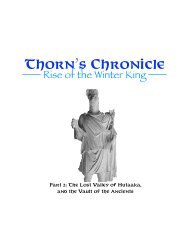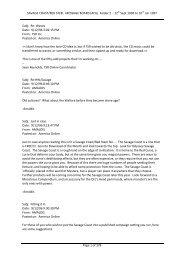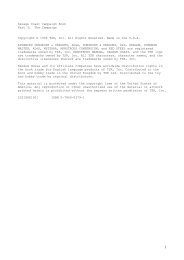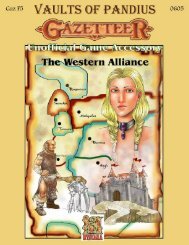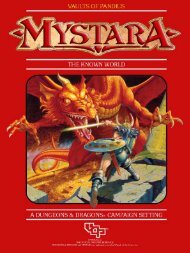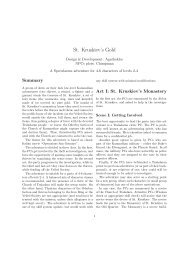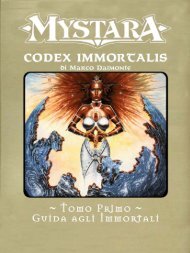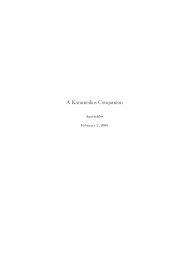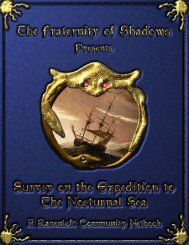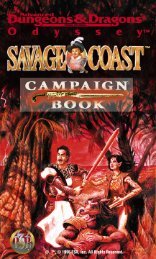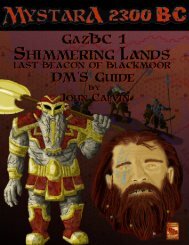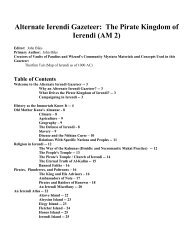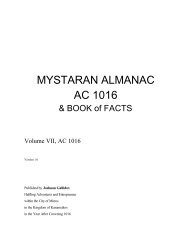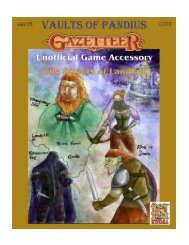Gaz F10 The Kingdom of Kaarjala - Vaults of Pandius
Gaz F10 The Kingdom of Kaarjala - Vaults of Pandius
Gaz F10 The Kingdom of Kaarjala - Vaults of Pandius
Create successful ePaper yourself
Turn your PDF publications into a flip-book with our unique Google optimized e-Paper software.
SOCIETY<strong>The</strong>y are generally reclusive and pursue ahunter-gatherer existence, but at leastthree packs herd reindeer. <strong>The</strong> lupins area very recent arrival to Norwold, cominghere from the Hyborean and Boreancoasts. Encounters with the packs havebeen rare thus far, but there have beenoccurrences <strong>of</strong> trade with the Viaskodaand the Vaarana clans. Conflicts with thelocal goblins tribes are infrequent, butexceedingly bloody. <strong>The</strong> lupins havegood relations with the Shonaks in thewest, a legacy <strong>of</strong> being allied Tribes <strong>of</strong>Law in the old conflicts <strong>of</strong> the Midlands.Note: Those who use Bruce Heard’sDragon Magazine article on lupin subracesmay consider the lupinkoiranlainento be a variety <strong>of</strong> Norwold Malamute,known as the <strong>Kaarjala</strong>n Lapphund. <strong>The</strong>Lapphunds sport grey, light brown, orwhite fur. <strong>The</strong> Malamute itself will notexist in <strong>Gaz</strong>F Norwold for another two tothree decades.Social StandingIn comparison to many other nations,<strong>Kaarjala</strong>n society is not highly stratified.Serfdom never existed; commoners,whether they live in villages or in thecountryside, own their own land and areresponsible for its productivity.Commoners historically would contributeto the community in the form <strong>of</strong> goods orlabor, but in recent centuries this hasevolved into the payment <strong>of</strong> land taxes.As in other realms, the commoner classis the largest in <strong>Kaarjala</strong>. It comprises abroad spectrum <strong>of</strong> occupations, fromfarmers, loggers, trappers, and herdsmenin the country to leather-workers,blacksmiths, carpenters, and othercraftsmen in the villages and towns.<strong>The</strong> townsfolk are overwhelminglySaamari, and <strong>Kaarjala</strong>n towns are similarto their southern counterparts with a level<strong>of</strong> bustle that is largely absent in the ruralregions. Nevertheless, crucial differencesexist. <strong>The</strong> largest <strong>Kaarjala</strong>n settlementsare small by the standards <strong>of</strong> the KnownWorld, and the “pr<strong>of</strong>essional” class (e.g.,scribes, accountants, and highlyspecialized trades) are largely absentoutside <strong>of</strong> the royal court; although this isslowly changing.Above the commoners are several ranks<strong>of</strong> nobility. At the very bottom is theuntitled noble, or Aatelinen (literally,“noble”). <strong>The</strong> most common occupants<strong>of</strong> this rank are members <strong>of</strong> fightingorders, but individual heroes have beengranted this rank on numerous occasions.In the case <strong>of</strong> the former, the honorific isgenerally not hereditary, and its holdersare not considered “true” nobles by thenobility. In the latter case, the rank ishereditary, but it does not come attachedwith a fief.<strong>The</strong> greater nobility includes the ranks<strong>of</strong>: Vapaaherra (baron) or Vapaaherratar(baroness), Kreivi (count) or Kreivitär(countess), and Ruhtinas (prince) orRuhtinatar (princess). <strong>The</strong> princes andprincesses <strong>of</strong> the royal house are referredto as Prinssi and Prinsessa, respectively.<strong>The</strong> king is referred to as the Kuningas,the queen the Kuningatar. In the past,ambitious or simply self-important kingsand queens also have referred tothemselves as Keisari (emperor) andKeisarinna (empress). Among the highernobility, a given title is used to addressall male members <strong>of</strong> the title-holder’sfamily.<strong>Kaarjala</strong>n nobility arose from a decisionby King Hanno that those who couldafford to maintain at least one soldierwould be exempted from ordinary taxeson one acre <strong>of</strong> land. Prior to that time theking ruled the realm directly, spendingmuch <strong>of</strong> his time traveling between hisestates and overseeing his army. Landtaxes were imposed in order to financethe construction and maintenance <strong>of</strong>fortifications and the small river fleet. Asa result <strong>of</strong> this decision, wealthierlandowners took it upon themselves tomaintain more soldiers, in order to securetax exemptions on larger swaths <strong>of</strong> land.Thus, the nobility grew from members <strong>of</strong>the peasantry who had enough wealth, orwere able to command enough physicalresources, to maintain soldiers.As the centuries passed, the noblescame to wield considerable economicpower, and they now own large tracts <strong>of</strong>land bought from the commoners. Bytradition, they are forbidden from taxingthe land <strong>of</strong> commoners living under theirjurisdiction, but they may demand goodsor military service in times <strong>of</strong> crisis.LanguageA number <strong>of</strong> languages are commonlyheard in <strong>Kaarjala</strong> and the larger northernregion.Alphatian: Although by no meanscommonly spoken, Alphatian is used by asmall group <strong>of</strong> Alphan expatriates wholive and work in Kaarja.Hymsprach: Commonly known toother races as Giantish, Hymsprach is thelanguage for all true giant-folk in thenorth (fire and larger).Litoniesu: <strong>The</strong> Litoniesu minority inKaarja is large and vibrant enough thattheir native tongue is still spoken, and itis the most commonly heard foreignlanguage in Kaarja.Qamuuq: Qamuuq (“our words”) isthe language spoken by the Shonaksinhabiting the eastern Everwinter Lands.Due to historical animosities Qamuuq isseldom heard in <strong>Kaarjala</strong>, but someVaarana clans make use <strong>of</strong> it whenconflicts are at low ebb. Qamuuq is aslightly variant dialect <strong>of</strong> the parentShonak language heard north <strong>of</strong> the Hilland Dale (<strong>Gaz</strong> F5 <strong>The</strong> Western Alliance).Saamari: Saamari is the native tongue<strong>of</strong> most <strong>Kaarjala</strong>ns, and it is the <strong>of</strong>ficiallanguage <strong>of</strong> court. It is unrelated to anyother Mystaran language except Vaarsu.A dialect is spoken by the people <strong>of</strong>Itämaa, which is 90% compatible.Vaarsu: This is the language spokenby the Vaarana. It has no written form,although a runic system derived fromboth Ilmarinen and the Antalians is inuse. It is related to Saamari, but centuries<strong>of</strong> separation and a measure <strong>of</strong> Antalianinfluence have made them almostmutually unintelligible. <strong>The</strong>re isconsiderable variation in colloquialVaarsu, with three main dialects, each <strong>of</strong>which can be divided into at least twosub-dialects. <strong>The</strong> slow-spoken westerndialects between Kaarja and the Icereachhave 30% compatibility with Saamari;whereas the southern dialects have 30%compatibility with Viaskan-Antalian.Northern Vaarsu – spoken north <strong>of</strong> theMaanselkä River – is characterized byclipped consonants and a quickintonation.Viaskan: This is the language spokenby the Antalian-descended Viaskodas,commonly called the Northern Bay15


